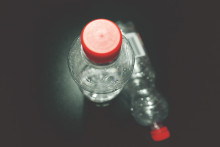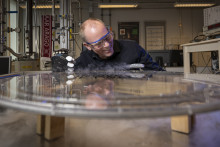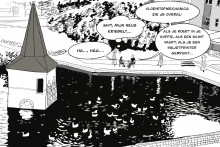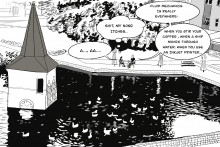It doesn’t happen often that first year bachelor students get their work published in a renowned journal. How did the UT group manage it? ‘It started as a regular project for our Dynamics course,’ answers one of the students, Mees Flapper. ‘We could choose any topic we liked and the water bottle flipping challenge was a big hit online at the time. As far as we know, there were no publications dedicated to the phenomenon. Our teachers Alvaro Marin and Jacco Snoeijer really liked the topic and later asked us to help them write a paper on it. That surprised us, but of course we agreed.’
Authors of the paper
The paper on ‘Water Bottle Flipping Physics’ will soon be published in the American Journal of Physics. It was written by the following group of authors: Pim Dekker, Lumen Eek, Mees Flapper, Remco Horstink, Anne R. Meulenkamp, Jelle van der Meulen, Stefan Kooij, Jacco Snoeijer and Alvaro Marin.
The students-authors of the paper
Flip and observe
The water bottle flipping challenge refers to spinning a bottle with water and making it land upright. It might not sound too difficult, but it is in fact rather curious (and unlikely) for such a fast rotating object to make a stable landing. Yet, it does. ‘If you flip a bottle and observe it carefully, you can see that it slows down in the air, which makes it land safely. We wanted to know why exactly that happens,’ says Lumen Eek. The group then started flipping partially filled bottles, filming them and analyzing their behavior.
Soon they figured it out. ‘We didn’t look at the water in the bottle as fluid, but instead assumed it to behave as something rigid,’ explains Pim Dekker. ‘Based on our experiments, we showed that the mass of a rotating object spreads throughout the object, reducing the velocity. That means that the distribution of mass makes the bottle slow down and increases the chances of a successful landing.’

The optimal amount of water
The amount of water in the bottle therefore seems to be the deciding factor for a successful water bottle flipping challenge. ‘Yes, exactly,’ confirms Flapper. ‘If the bottle is too full or too empty, the mass can’t spread and the bottle will tip over easily. The optimal amount of water in a bottle seems to be between ¼ and 1/3.’ These findings don’t only apply to water bottles. ‘We also demonstrated the same effect with a cylinder filled with two tennis balls,’ adds Eek. ‘The physics remain the same.’









